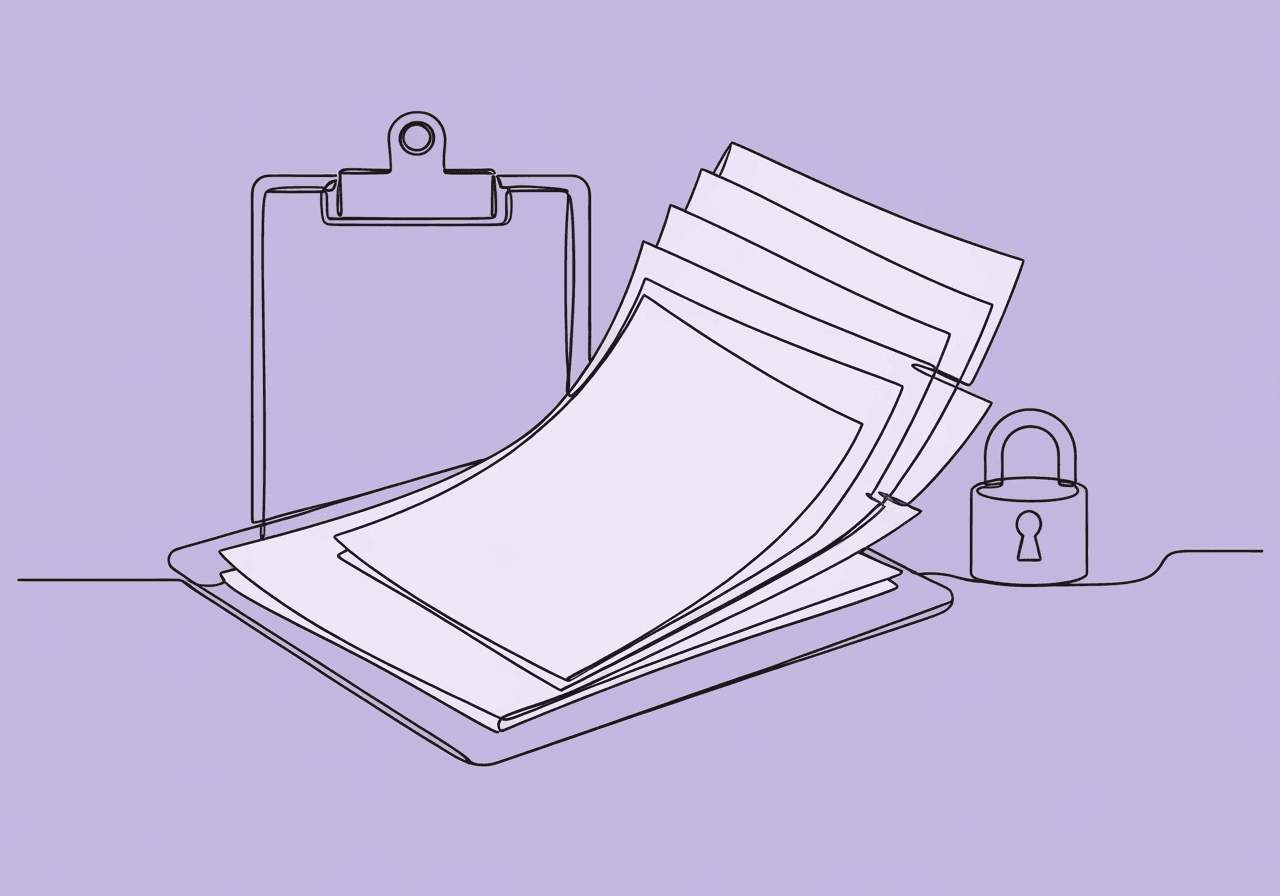Essential HIPAA Record Release Documentation for BCBAs

In ABA therapy, where client progress depends on close teamwork among BCBAs, RBTs, and families, mishandling protected health information (PHI) can lead to breaches, legal risks, and disrupted care. BCBAs and RBTs often face requests to share records for transitions, insurance, or legal needs. This makes HIPAA record release documentation a critical safeguard. As the U.S. Department of Health and Human Services notes in their guidance on privacy basics, behavioral health providers like ABA practitioners must navigate strict rules to protect sensitive data on autism spectrum disorder and therapy outcomes.
This guide equips BCBAs and RBTs with evidence-based tools for compliance. It draws from HHS guidelines and the Behavior Analyst Certification Board (BACB) Ethics Code. You'll learn the essentials of valid authorizations, step-by-step request handling, ethical duties for transfers, the minimum necessary standard, exclusions for certain documents, timelines with fees, and RBT roles—all tailored to ABA practices. By following these, you can ensure continuity of care while minimizing risks.
Here are key takeaways to guide your practice:
- Always verify HIPAA record release documentation elements like signatures and expiration dates before sharing PHI.
- Apply the minimum necessary standard BCBA to limit disclosures and reduce breach risks.
- Train RBTs on their support roles in secure coordination without independent access.
- Retain authorizations for six years and full records for seven years per relevant guidelines.
- Use encrypted tools for transfers to uphold BACB ethics during client transitions.
How to Validate HIPAA Authorizations in ABA
A valid HIPAA authorization serves as the cornerstone for releasing PHI in ABA settings. It ensures clients' consent before sensitive behavioral health data is shared. Under the HIPAA Privacy Rule, authorizations are required for disclosures beyond treatment, payment, or health care operations. This includes sharing records with schools or new providers.
For behavioral health, it covers ABA session notes, progress reports, and assessments. These often contain psychotherapy-like notes that warrant extra protection. Key elements of a valid authorization form ABA include a specific description of the information to release. It also needs names of disclosing and receiving parties, purpose of disclosure, expiration date or event, patient signature (or representative's with authority), revocation rights, refusal consequences, and redisclosure risks.
HHS guidance on individuals' right to access their health information explains that patients requesting their own records do not need this form. They have a direct right to access. But for third-party releases in ABA, BCBAs must verify the form's completeness. This avoids invalid disclosures.
ABA clinics should use standardized templates compliant with these rules. Imagine a scenario where a family requests records for a school transition. You'd check for all elements right away. Psychotherapy notes—detailed personal reflections on client behaviors—require separate authorization for nearly all uses. Even treatment coordination needs it, as HHS clarifies in their privacy guidance for professionals.
Non-compliance can result in fines up to $71,162 per violation. This underscores the need for thorough checks. For details on current penalties, see HIPAA Violation Penalties 2024 Update.
To implement effectively: Review forms for all core elements before proceeding. It's essential to catch gaps early. Retain copies in the client's secure file for at least six years. This aligns with HIPAA retention standards—check HIPAA Record Retention Requirements for more. Train staff to spot invalid forms, like those lacking expiration dates. Regular drills help build this skill.
By prioritizing these requirements, ABA providers uphold client trust and legal standards.
Step-by-Step: Fulfilling Record Requests in ABA
Handling a record request in ABA requires a structured approach. You must verify legitimacy, scope PHI appropriately, and secure transmission. Start with authentication. Confirm the requester's identity and relationship to the client. Use government-issued ID or legal verification for guardians.
If authorization is needed, ensure it's valid per HIPAA elements outlined above. Next, assess scope under the minimum necessary standard BCBA. Release only what's essential for the purpose. For example, share behavior plans for continuity of care. But hold back full therapy notes unless specified.
As Compliancy Group explains in their overview, this standard limits disclosures to authorized staff and relevant data. It reduces breach risks in ABA's data-heavy environment. Secure the release by using encrypted electronic methods. Opt for HIPAA-compliant portals or certified mail for physical copies.
Document the entire process. Log the request date, verification steps, disclosed items, and recipient details. For tips on secure storage, explore our HIPAA-Compliant ABA Clinic Guide.
Follow these steps for efficiency:
- Receive and log the request within 24 hours. Quick logging prevents delays.
- Verify authorization and scope within 48 hours. Double-check against checklists.
- Compile and review records for minimum necessary compliance. Redact if needed.
- Transmit securely and notify the client of the disclosure. Keep them informed.
- Archive the log for audits. This supports future reviews.
This process, grounded in HHS protocols on minimum necessary requirements, prevents over-disclosure. It also supports BACB ethical duties. In high-volume ABA practices, automating verification via software can streamline things. Just ensure it doesn't compromise security.
BCBA Ethical Duties in Record Transfers
BCBAs bear primary responsibility for ethical record transfers. They must ensure alignment with the BACB Ethics Code (effective 2022). This promotes uninterrupted client services. Code 3.14 mandates contingency plans for service continuity. Documented transitions avoid disruptions in ABA therapy for conditions like autism.
Transfers must include up-to-date assessments, treatment plans, and data sheets. Share them only with client consent or legal mandate. Confidentiality remains paramount. Disclose PHI only with informed consent. Exceptions cover harm prevention or court orders.
The BACB Ethics Code for Behavior Analysts requires secure handling during transfers. Document all communications to the incoming BCBA or BCaBA. For instance, during staff changes, prepare a handover summary. Redact non-essential details to stay compliant.
Ethical lapses, like unauthorized sharing, can lead to certification revocation. To comply: Develop Continuity of Services Plans (CoSPs) outlining transfer protocols. Make them clear and actionable. Coordinate with stakeholders, such as families, before releasing records. Their input matters. Retain full records for seven years post-service, per BACB guidelines. See the BACB Ethics Code for Behavior Analysts for full details. For practical tips, check our BCBA Record Retention Essentials Guide.
These obligations not only meet BACB standards. They also foster trust. This enables seamless care transitions in ABA.
Applying the Minimum Necessary Standard in ABA
The minimum necessary standard BCBA restricts PHI access, use, and disclosure. It limits them to only what's needed for the purpose. This is a core HIPAA Privacy Rule protection. It's vital for ABA's collaborative yet sensitive environment.
Covered entities, including ABA clinics billing insurance, must implement policies. These limit staff access—for example, RBTs view only session data. BCBAs access full plans. HHS guidance on minimum necessary requirements emphasizes this. It prevents unnecessary exposure of behavioral insights.
Exceptions apply. No limits for treatment disclosures, like sharing progress data with schools. Or for patient-requested access. In ABA, this means excluding internal supervisory notes from routine releases.
Violations, like over-sharing during audits, carry penalties up to $71,162 per violation. For the latest on enforcement, review 2024 HIPAA Violation Penalties.
Practical application includes: Role-based access in electronic health records (EHRs). It keeps things controlled. Annual training on de-identifying data where possible. Refreshers keep teams sharp. Auditing disclosures quarterly to confirm compliance. Spot issues early.
As the American Psychological Association outlines in their patient release resources, integrating this standard into ABA workflows reduces breach incidents. It focuses on targeted releases. This enhances both privacy and efficiency.
Handling Exclusions for Sensitive ABA Records
Not all ABA documents qualify for standard release. Certain types demand exclusion to protect privacy. Internal review documents, such as BCBA peer consultations or incident reports not tied to care, fall outside routine disclosures.
Psychotherapy notes—detailed clinician impressions of client behaviors—require separate authorization. HHS classifies them distinctly from general records in their privacy guidance for professionals. In ABA, exclude raw data logs without context. Or legal privilege claims, especially in subpoenas. For strategies, see our BCBA Subpoena Legal Guide.
Mandated exclusions also cover substance use details under 42 CFR Part 2. These overlap with some behavioral health PHI.
Guidelines for handling: Flag sensitive items during review. Mark them clearly. Obtain explicit consent for any exceptions. Don't assume. Use redaction tools for partial releases. They help precisely.
This selective approach minimizes risks. It allows necessary sharing for continuity, as supported by HHS mental health privacy topics.
What Are the Timelines, Fees, and RBT Roles?
HIPAA mandates responding to record requests within 30 calendar days. You can extend to 60 with notice. States like California shorten this to 15 days, per the Medical Board of California on access records.
For ABA providers, delays in releasing therapy timelines can disrupt care transitions. Authorizations themselves lack a federal expiration. But they must specify one, often tied to events like case closure.
Fees must be reasonable and cost-based. They cover labor and supplies but not electronic retrieval. HHS recommends a $6.50 flat rate for patient-direct access in their privacy guidance.
RBTs play a key support role in coordination. They document sessions objectively. They flag requests to supervisors. And ensure secure handling without independent access.
Under BACB Ethics Code 2.0, RBTs report breaches promptly. They use compliant tools. Training emphasizes confidentiality. This reduces errors in data entry.
To coordinate effectively: RBTs log sessions immediately post-service. Fresh details matter. Assist in compiling non-sensitive portions under BCBA oversight. Stay in your lane. Verify secure transmission methods. Double-check every step.
This timeline and role clarity streamlines processes. It maintains compliance through HHS basics on privacy.
Frequently Asked Questions
What Are the Specific Requirements for a HIPAA Authorization Form in Behavioral Health?
A HIPAA authorization form in behavioral health, including ABA, must detail the information to release. It needs parties involved, purpose, expiration, signature, revocation rights, refusal impacts, and redisclosure warnings. As HHS stresses in their guidance, use it for non-routine disclosures. Invalid forms risk fines up to $71,162 per violation—for details, see HIPAA Violation Penalties 2024. BCBAs should validate before proceeding. This protects PHI like therapy notes.
How Does HIPAA Regulate the Release of Psychotherapy Notes in ABA?
Psychotherapy notes in ABA—personal clinician insights—require separate authorization for most disclosures. Even treatment-related ones need it, per HHS privacy guidance for professionals. Exceptions include legal defense or audits. But routine releases are barred. This shields sensitive behavioral data. Always segregate from general records.
How Can BCBAs Ensure Compliance with the Minimum Necessary Standard?
BCBAs limit releases to essential PHI, like core plans. Do this via policies, role-based access, and audits. HHS exempts treatment shares but mandates training in their minimum necessary guidance. In ABA, this avoids over-disclosing data. Tools like EHRs enforce limits effectively.
What Are the BACB Requirements for Transferring Client Records?
BACB Code 3.14–3.15 requires consent-based transfers with full documentation. Use secure methods and continuity plans, as outlined in the BACB Ethics Code for Behavior Analysts. Document communications. Retain seven years. This ensures ethical handoffs without breaches.
How Long Does a Provider Have to Respond to a HIPAA Request?
Providers must respond within 30 days, extendable to 60, per HHS facts on timely responses. State laws may shorten this. ABA clinics should log requests promptly. This meets timelines and supports care continuity.
What Role Do RBTs Play in HIPAA-Compliant Coordination?
RBTs document accurately and report issues to BCBAs. They use secure systems without independent releases, per BACB Ethics 2.0. Focus on objective notes and breach alerts. This aids coordination while upholding confidentiality.
Wrapping up, here's how to put HIPAA and BACB rules into action for your practice. BCBAs and RBTs must treat HIPAA record release documentation as a protective framework. It balances access with privacy and fosters ethical ABA practice. Evidence from HHS and BACB shows compliant processes reduce violations—common in behavioral health. They enable smoother client transitions, with breaches averaging $9.77 million in costs for 2024, per Healthcare Data Breach Cost Report.
For practical next steps, audit your current authorization forms against HHS checklists today. Schedule team training on minimum necessary rules quarterly. Integrate secure EHRs for RBT documentation to automate compliance. Download our free authorization form ABA template from Praxis Notes to get started—visit Praxis Notes HIPAA Resources. Or book a compliance consultation to tailor these to your clinic. By embedding these habits, you'll deliver value-driven care that prioritizes client outcomes in a regulated landscape.
Popular in Compliance & HIPAA
- 1
ABA Documentation Checklist: RBT Compliance Guide 2025
6089 min read - 2
BCBA Procedural Fidelity Checklist: Essential H-6 Guide
5776 min read - 3
RBT Renewal Competency Documentation Guide for BCBAs
4406 min read - 4
BCBA Ethical Documentation Best Practices
3806 min read - 5
RBT Supervision Log Audit Checklist for BCBAs
3336 min read
Popular in Compliance & HIPAA
- 1
ABA Documentation Checklist: RBT Compliance Guide 2025
6089 min read - 2
BCBA Procedural Fidelity Checklist: Essential H-6 Guide
5776 min read - 3
RBT Renewal Competency Documentation Guide for BCBAs
4406 min read - 4
BCBA Ethical Documentation Best Practices
3806 min read - 5
RBT Supervision Log Audit Checklist for BCBAs
3336 min read
Related Resources
Explore more helpful content on similar topics

BCBA Data Breach Documentation Checklist: 10 Steps
Discover the essential 10-step BCBA data breach documentation checklist to safeguard your practice. Ensure HIPAA compliance in ABA settings and BACB ethical reporting through thorough risk assessments, timely notifications, and staff training. Protect client privacy today!

ABA Documentation Checklist: RBT Compliance Guide 2025
Discover the essential ABA documentation checklist for RBTs in 2025. Master BACB guidelines, HIPAA compliance, and billing tips to ensure ethical practice and avoid errors. Learn actionable steps now!

ABA Telehealth Documentation 2025: Key Updates
Stay ahead of ABA telehealth documentation 2025 updates. Learn essential requirements, updated CPT codes, HIPAA compliance tips, and best practices for RBTs and BCBAs to avoid billing denials.